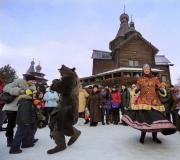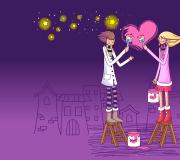Drawing with a candle and paints in kindergarten. Unconventional technique of drawing with wax crayons (candles) and watercolors
Wax and watercolor drawing. Drawing technique
All children love to draw and create their own masterpieces. Today we will tell you about the magical, unusual, unconventional drawing with wax and watercolor on paper and we assure you that your child will be infinitely happy that he will succeed and he will probably want to show off his drawing.
Today we introduce you to an unusual technique - drawing with a candle. This drawing technique usually delights children, captivating them with the final effect of the image appearing on a sheet of paper. Drawing using this technique gives the child confidence in working with paint, develops imagination and fine motor skills, which is very important for children of preschool and primary school age. It’s even a kind of game that doesn’t tire kids, but rather gives them positive emotions.

Drawing with a candle
First, you need to draw a picture of a candle on a white sheet of paper. We take a piece of a candle and create an outline of the future drawing. By the way, you can draw not only with a candle, but also with wax pencils, the effect will be the same. Since children do not know about the property of wax to repel water, for them this method of drawing will seem magical and incredible.
To make it easier to create a sketch, before moving on to the second step of work - drawing with watercolors, you can invite your child to first draw a picture with a simple pencil, and only then trace it along the outline with a candle. You can simplify the task even further - take a regular coloring book and trace it along the contour with a piece of wax or a candle.
We invite you to look through our section and choose the drawing that your baby will like best.

Magical candle painting
This fish is drawn with a wax colored pencil.

Drawing with a candle
Next we will paint with watercolors. It is better to use darker watercolor colors: blue, black, purple, so the effect will be more noticeable. We take more paint, but less water. Take a wide brush, dip it in watercolor paint or gouache and cover a sheet of paper with large strokes. The paint will slide off the created outline, since the paraffin from which the candle is made is greasy. The drawing will appear as if by magic!

Drawing with a candle
After the drawing has dried, you can additionally draw some elements using felt-tip pens or markers.
For your information: now many children have a lack of self-confidence, poorly developed imagination, and lack of independence. The child is afraid to do something and create on his own; it seems to him that he will not succeed. But the work carried out in kindergarten, carried out using this drawing technique, showed very positive dynamics in the psychological mood of the children.
Here's what the specialist says:
“I watched with pleasure how the guys in our classes, holding their breath, looked at their drawings and when something appeared on the sheet, there was an explosion of emotions in the group from what they saw.”
Let your child feel positive emotions both from the process itself and from the result of wax painting!
Drawing daisies with wax crayons and watercolors. Video
We draw a ladybug with wax and watercolors. Video
Happy creativity!

Drawing with candles and watercolors. Magic drawings

Drawing with candles and watercolors. Magic drawings

Drawing with candles and watercolors. Magic drawings

Drawing with candles and watercolors. Magic drawings

Drawing with candles and watercolors. Magic drawings

Drawing with candles and watercolors. Magic drawings
Unconventional drawing
Wax crayons and wax candle + watercolor
Drawing is one of the important types of art, which is not only a way to convey a particular image, but also internal feelings, perception of the external world, emotions, fantasies and much more.
Target: introduce children to non-traditional drawing techniques.
There are many non-traditional drawing techniques; their unusualness lies in the fact that they allow children to quickly achieve the desired result.
Having become acquainted with the methodological literature:
| A. V. Nikitina | “Non-traditional drawing techniques in kindergarten” |
|
| I. A. Lykova | “Methodological manual for specialists of preschool educational institutions” |
|
| T. N. Doronova | “Nature, art and visual activities of children” |
|
| R. G. Kazakova | “Art activities in kindergarten” |
After reading this literature, I found a lot of interesting ideas and set myself tasks:
develop technical drawing skills in children;
introduce children to unconventional drawing techniques;
learn how to create your own unique image in a drawing using unconventional drawing, using wax crayons of different colors and a wax candle.
Materials: wax crayons and a wax candle, thick white paper, watercolors, a bird feather template, scissors, glue, napkin, brush, glass of water, a simple pencil for each child.
Progress:
Children guess the riddle:
What kind of miracle bird is this?!
Not an owl or a tit,
Not a crane or a thrush...
Like an open fan tail...
Blue, green, red -
How many colors are there on feathers?
Just an important gentleman,
Walks around the yard... (Peacock).
Children's answers.
Educator: Well done, children. We guessed the riddle.
Guys! Listen to the poem:
There was a peacock at the zoo. A very important citizen.
He walked…looked at us. And he wiggled his tail.
And on ours. before our eyes. He waved his tail.
The tail opened...beauty. Multi-colored tones.
The overflows began to play. And the colors all sparkled.
It’s like he’s blown a fan. The peacock surprised us so much.
We read about him in books. Everyone knew his habits.
As we saw it up close... We quickly opened our mouths.
You can’t call it beauty... You can’t even find the words.
It was like we were in a fairy tale. And we met a peacock.
Did you like the poem?
Children's answers.
Please tell me what, in your opinion, is the most beautiful thing about a peacock?
Children's answers.
Look at the photo.
Of course, the most beautiful detail in a peacock's appearance is its tail.
A peacock needs a beautiful upper tail of feathers. In order to conquer the female, the peacock spreads its plume of feathers. Only the male peacock has a beautiful feather outfit.
Physical education minute:
We alternately spread and close the fingers, first on the right hand, then on the left, then on both hands at the same time.
Physical education lesson “Bird”:
| The bird was flying | cross your palms |
| The bird is tired. The bird folded its wings, | make a castle |
| The bird washed its feathers. | lock rotation |
| The bird moved its beak | straightened connected little fingers represent a beak |
| The bird found the grains. The bird ate the grain, | joined little fingers tapping on the table |
| She opened her wings again, Flew. | crossed palms making waves |
Educator: Guys, let's cut out peacock feathers from paper.
Each child receives a template (peacock feather), a sheet of white paper, scissors and a simple pencil.

On a cut out (according to the template) peacock feather, apply a design with wax crayons and a wax candle. It turns out that there is a “magic drawing”, it is there, but it is not visible if we draw with a wax candle.

Then we paint the feather with watercolors in one or more colors. The drawing appears and we see where it was drawn with a wax candle, since it remains unpainted. Drawing is also done with wax crayons.
After the drawing (feather) has dried, we glue it to the peacock with glue.
This is what we got. 
Conducting classes using non-traditional techniques:
helps relieve children's fears;
develops self-confidence;
develops spatial thinking;
teaches children to freely express their ideas;
encourages children to creative searches and solutions;
teaches children to work with a variety of materials;
develops a sense of composition, rhythm, color, color perception;
develops creative abilities.
There is an artist in each of us, and we don’t even know about it. Remember the parable of the “buried talents”. But indeed, many “bury” their talent in the ground, unable to reveal themselves. This is how “undiscovered talents” walk the streets and live everyday lives. It’s just that no one paid attention to the inclinations and abilities in childhood. You need to remember a simple rule - there are no untalented children, there are undiscovered children. And we, adults, must help reveal these talents!
As V. A. Sukhomlinsky said: “The origins of children’s abilities and talents are at their fingertips. From the fingers, figuratively speaking, come the finest threads-rivulets, which are fed by the source of creative thought. The more skill in a child’s hand, the smarter the child.”
Master class on drawing for teachers and children of senior school age
Master class on drawing. Mixed media (watercolor - candle) “Flap of one wing”
Author: Melnikova Tatyana Ilyinichna, teacher of fine arts, municipal educational institution of additional education for children “Children’s Art School No. 1 of Nadym”.The master class is designed for children of senior school age and teachers.
Purpose: a good idea for a postcard or cover design.
Target: acquiring skills in wax and watercolor.
Tasks: search for an expressive coloristic and compositional solution.
Educational: introduction to mixed media - wax and watercolor.
Developmental: development of skills in various techniques;
- development of combination skills in decorative images;
- development of imagination, fantasy, creative potential;
- development of associative, figurative thinking, ability to imagine;
Educating: nurturing students’ attention, conscientious attitude to work, instilling discipline, accuracy, and independence.
For many millennia, flowers have symbolized the beauty, joy and perfection of nature among people. They give everyone, regardless of whether you are a prince or a beggar, that wonderful world, when you get into it you feel happy and loved. Therefore, people have always tried to decorate with these amazing gifts of nature not only the festive and solemn days of their lives, but also everyday life, which, as we know, people have much more of.
It seems that Mother Nature herself tried and gifted us with these wonderful creatures, which for many thousands of years in a row have brought beauty and joy into our lives, giving us a good mood and emotional health at any time of the year.
According to scientists, there are more than 270,000 varieties of flowers on earth. And each flower is beautiful and unusual in its own way and carries within itself that piece of joy that nature put into it to make our lives brighter and a little happier.
All peoples of the world associate flowers with warmth, sun, spring and joy. And it doesn’t matter whether it’s winter outside or summer, autumn or spring. Flowers always remain symbols of a good mood and a wonderful time of year - spring and summer.
Each flower is shrouded in a ghostly and mysterious aura, that magical mood that it bestows on all people without exception, be it a man or a woman, a small child or an elderly person.
We will paint a flower with a candle in combination with watercolors.
Materials:
We will need the following: watercolor paper (linen), candle
(light colors), brushes (squirrel, kolinsky No. 10-15, bristles), contours on the fabric.
Progress:

We place our sheet of paper horizontally. We outline the middle of the flower.

From the middle of the flower we draw daisy-like petals with a candle and lead them to the edge of our format. The candle can be used with the tip, end or flat. The candle leaves a mark on the surface of the paper in the form of a stroke. Closely spaced strokes form a spot. We light a candle and drip melted wax onto our work in a chaotic manner.


Then we moisten the entire sheet with water using a spray bottle and select a color palette.

We completely cover our format with warm shades of watercolor. Watercolor, thanks to its transparency properties, allows you to create light and airy compositions.

The main property of wax is to repel water. The method of working in this technique is based on this property. The combination of watercolor and candle gives a completely unexpected effect: if you go over the wax with watercolor, then the places on the paper that are not painted over with wax will be painted with paint. This technique of work is called mixed.
The next stage of work is to remove excess moisture from the petals of our flower.


And we compact the color between the petals. Making it brighter and more interesting.

After the work has dried, take a brush with bristles and a darker shade of color than in our work and apply a spray.



And to complete our work, you can decorate our flower with fabric contours.

And now, with a sense of accomplishment, we look once again at the finished work)))
And one more thing: it will be great if you formalize the work! A greenish passe-partout would be very suitable here...)))
I wish everyone pleasant creativity and inspiration!!!
JOURNEY INTO HISTORY The history of the invention of candles can be traced back to the heyday of the Roman Empire, which gave the world many useful inventions. It was the Romans who first began to use wicks in the manufacture of candles, which they used to illuminate their homes and temples, and also used them to move through dark city streets and trees.



JOURNEY INTO HISTORY Wax candles do not produce soot or unpleasant odor; they burn brightly and evenly. But fat in large quantities is easier to obtain than wax, so wax candles were expensive and were used only in the homes of wealthy citizens, nobles and the royal court, and thus began the history of the wax candle.


CANDLE MAKING TECHNOLOGY They took a twisted thread - the future wick, twice as long as the candle and tied it to a stick, folding it in half and weaving the ends. On one stick there were several blanks for candles. Next, these wicks were dipped into melted lard, removed and allowed to cool. This procedure was repeated several times until the candles of the required thickness were obtained.


MODERN HISTORY OF CANDLES Massive extraction of paraffin made it possible to make cheap candles, since it cost much less than wax and similar substances. At the same time, paraffin burns as brightly as wax, without emitting an unpleasant pungent odor.

LESSON EQUIPMENT You will need: - candles - white paper - watercolor paints - brush - oilcloth (newspaper) on the table Creative task: 1. Cover the table with newspaper. 2. Spread a sheet of white paper and, pressing firmly, make a design with a candle. 3. Paint over this design with watercolors

What you need to know! Watercolors WILL adhere to, or be absorbed into, the paper, but not where it is covered with wax. Watercolor paints are held to paper by a force called AGRITION. But this did not happen where wax is present, because there is a large force between it and the paper, which is called ADHESION. Game 1. You can draw several different simple drawings with a candle and invite children 2-4 years old to use watercolor paints to find out what is drawn. 2. Children can draw their own designs with a candle and develop them with paint.

It seems that contemporary art is, first of all, an “arms race”. Everyone competes not only in skill and quality of workmanship, but also in how, where and from what to create their new masterpieces.
And if some attempts cause, at best, a slight smile or bewilderment, then others are truly impressive or, at least, arouse genuine interest.Drawing with a candle
This time we'll talk about French-Canadian artist Steven Spazuk, who also could not keep his creative imagination within the proposed framework and tried out a new type of art of painting - drawing with candles and watercolors.
Immediately, somehow involuntarily, associations emerge with old Soviet entrances, where on the ceilings one could find many “creations” with fire, or rather with matches or cigarette butts, but here there is really something to see.


The pictures are beautiful. And most importantly, in most cases they are unpredictable. After all, fire is not the most malleable element, but it is very capricious even in matters of creativity, and it is simply impossible to plan the thickness of lines and strokes with centimeter accuracy. Therefore, the artist invents in his imagination only a general direction, a theme, while the candle and the paper already create their own art.
Therefore, not only the works themselves are interesting, but also the technique of drawing with a candle itself - it is too unconventional and interesting.
Prophetic Vision
Thanks to the unusual method of applying images, the paintings look as if shrouded in a mysterious haze. It is more reminiscent of a dream - the same one in which, according to the artist, they received a hint from higher powers about what they should do.

Stephen said that in that prophetic vision, he walked through an amazing art gallery created with the help of fire, gradually realizing exactly how he would work. 14 years have passed since then, and the artist has received recognition all over the world. His works, painted with a candle, delight and inspire lovers of everything unusual and beautiful; they are confirmation that not everything has yet been created and invented - perhaps the higher powers will one day have a good offer for us.




